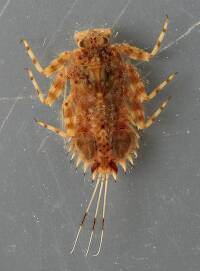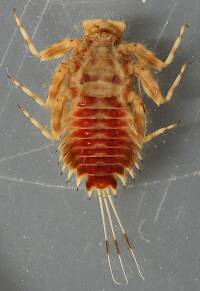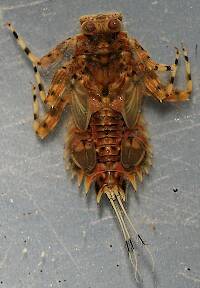
Salmonflies
Pteronarcys californica
The giant Salmonflies of the Western mountains are legendary for their proclivity to elicit consistent dry-fly action and ferocious strikes.
Featured on the forum

This is a striking caddis larva with an interesting color pattern on the head. Here are some characteristics I was able to see under the microscope, but could not easily expose for a picture:
- The prosternal horn is present.
- The mandible is clearly toothed, not formed into a uniform scraper blade.
- The seems to be only 2 major setae on the ventral edge of the hind femur.
- Chloride epithelia seem to be absent from the dorsal side of any abdominal segments.
Based on these characteristics and the ones more easily visible from the pictures, this seems to be Grammotaulius. The key's description of the case is spot-on: "Case cylindrical, made of longitudinally arranged sedge or similar leaves," as is the description of the markings on the head, "Dorsum of head light brownish yellow with numerous discrete, small, dark spots." The spot pattern on the head is a very good match to figure 19.312 of Merritt R.W., Cummins, K.W., and Berg, M.B. (2019). The species ID is based on Grammotaulius betteni being the only species of this genus known in Washington state.
- The prosternal horn is present.
- The mandible is clearly toothed, not formed into a uniform scraper blade.
- The seems to be only 2 major setae on the ventral edge of the hind femur.
- Chloride epithelia seem to be absent from the dorsal side of any abdominal segments.
Based on these characteristics and the ones more easily visible from the pictures, this seems to be Grammotaulius. The key's description of the case is spot-on: "Case cylindrical, made of longitudinally arranged sedge or similar leaves," as is the description of the markings on the head, "Dorsum of head light brownish yellow with numerous discrete, small, dark spots." The spot pattern on the head is a very good match to figure 19.312 of Merritt R.W., Cummins, K.W., and Berg, M.B. (2019). The species ID is based on Grammotaulius betteni being the only species of this genus known in Washington state.

Troutnut is a project started in 2003 by salmonid ecologist Jason "Troutnut" Neuswanger to help anglers and
fly tyers unabashedly embrace the entomological side of the sport. Learn more about Troutnut or
support the project for an enhanced experience here.

I wish I had photographed this one against a ruler or some kind of size reference. The genus ID is confident, and I am very tentatively calling it Eurylophella minimella based on the keys in Allen & Edmunds (1963) and the following judgment of its characteristics:
1. Has a "medium" rather than "large" tubercle on the styliger plate between the forceps bases (pretty sure)
2. Body and legs not sprinkled with fine brown dots (obvious)
3. Tails with dark annulations at the apex of each segment (obvious)
4. Terga brown and sterna pale; sterna 2-7 lacking large dark brown median macula, but each having 4 dark dots (pretty sure)
5. Penes widest near base, not mid-length (pretty sure)
6. Penes with a "shield-shaped" rather than "oblong" subapical excavation (not sure)
7. Dark brown apical macula on femora "distinct" rather than "faint" (very unsure on this judgment call)
If i'm wrong, i'm mostly likely wrong about point 7, which would make this Eurylophella verisimilis instead (forewings 8–9 mm long, vs 6–7 for minimella). If i'm wrong about point 6 (also very possible), the options would be Eurylophella aestiva and Eurylophella bicolor.
1. Has a "medium" rather than "large" tubercle on the styliger plate between the forceps bases (pretty sure)
2. Body and legs not sprinkled with fine brown dots (obvious)
3. Tails with dark annulations at the apex of each segment (obvious)
4. Terga brown and sterna pale; sterna 2-7 lacking large dark brown median macula, but each having 4 dark dots (pretty sure)
5. Penes widest near base, not mid-length (pretty sure)
6. Penes with a "shield-shaped" rather than "oblong" subapical excavation (not sure)
7. Dark brown apical macula on femora "distinct" rather than "faint" (very unsure on this judgment call)
If i'm wrong, i'm mostly likely wrong about point 7, which would make this Eurylophella verisimilis instead (forewings 8–9 mm long, vs 6–7 for minimella). If i'm wrong about point 6 (also very possible), the options would be Eurylophella aestiva and Eurylophella bicolor.
Taxon on Jul 10, 2006July 10th, 2006, 12:09 pm EDT
Jason-
Your identification appears spot on. You may well have already considered them, but here are three key matches:
1} Genitalia illustrated in Leonard & Leonard p. 125 figure 75, which seems to match the claspers perfectly, and would likely match the penes perfectly as well, were they not a bit damaged
2) Sternites "with four small dots sometimes elongaged into narrow streaks" as described in Leonard & Leonard p. 50
3) "stigmatic area of fore wing milky" as described in Leonard & Leonard p. 50
Your identification appears spot on. You may well have already considered them, but here are three key matches:
1} Genitalia illustrated in Leonard & Leonard p. 125 figure 75, which seems to match the claspers perfectly, and would likely match the penes perfectly as well, were they not a bit damaged
2) Sternites "with four small dots sometimes elongaged into narrow streaks" as described in Leonard & Leonard p. 50
3) "stigmatic area of fore wing milky" as described in Leonard & Leonard p. 50
Troutnut on Jul 10, 2006July 10th, 2006, 4:39 pm EDT
Thanks for double-checking me. It's that much more convincing, now, because I arrived at needhami by different means. I used the keys from Allen & Edmunds' revision of the Ephemerellidae, though they can be a bit difficult to follow.
Jason Neuswanger, Ph.D.
Troutnut and salmonid ecologist
Troutnut and salmonid ecologist
GONZO on Oct 14, 2008October 14th, 2008, 5:12 pm EDT
I believe that this specimen is Eurylophella. In fact, except for the male dun identified by David Funk (#773), all of the duns and spinners (#549, #597, #546, #548, #598) in the E. needhami section appear to be Eurylophella. There also seems to be a male Eurylophella spinner (#544) in the E. invaria section, and a female Eurylophella spinner (#600) that has not been identified.
Although some shots of the "naughty bits" of this specimen show damage or extraneous clutter, the first shot is clear and represents Eurylophella genitalia as depicted in McDunnough's 1931 review of the "bicolor" group--broad at the base, tapering apically, with a slight excision at the apex. The claspers of E. needhami are quite similar to Eurylophella, but the shape of the penes are very different. (McDunnough's original 1925 description has an illustration of the elongate tips of needhami.)
The characteristic Eurylophella genitalia can also be seen in #549 and the specimen (#544) in the invaria section. Compare the genitalia of #544 (Eurylophella) to #545 (E. invaria). The latter has the bulge at the tip of the second segment of the clasper and the penes shape that is attributable to invaria.
In addition to Dr. Funk's comments (in the thread associated with #773) about Eurylophella subs having blackish wings and orange eyes (males), these traits are also worth noting:
1. Bodies are usually brown (ranging from dark to orangish or yellowish brown), and legs are pale yellowish, often with a dark spot or spots on the coxae and sometimes on the trochanters.
2. Abdomen is somewhat slender with a long 9th segment. (This feature is mentioned in most keys to the nymphs, but not the adults. I think it is one of the easiest ways to recognize this genus.)
3. Although variable, many have a dorsal pattern of longitudinal stripes.
4. Many species have a ventral pattern of (often 4) spots and/or lateral slashes.
5. Tails usually have dark marks at segments.
Although some shots of the "naughty bits" of this specimen show damage or extraneous clutter, the first shot is clear and represents Eurylophella genitalia as depicted in McDunnough's 1931 review of the "bicolor" group--broad at the base, tapering apically, with a slight excision at the apex. The claspers of E. needhami are quite similar to Eurylophella, but the shape of the penes are very different. (McDunnough's original 1925 description has an illustration of the elongate tips of needhami.)
The characteristic Eurylophella genitalia can also be seen in #549 and the specimen (#544) in the invaria section. Compare the genitalia of #544 (Eurylophella) to #545 (E. invaria). The latter has the bulge at the tip of the second segment of the clasper and the penes shape that is attributable to invaria.
In addition to Dr. Funk's comments (in the thread associated with #773) about Eurylophella subs having blackish wings and orange eyes (males), these traits are also worth noting:
1. Bodies are usually brown (ranging from dark to orangish or yellowish brown), and legs are pale yellowish, often with a dark spot or spots on the coxae and sometimes on the trochanters.
2. Abdomen is somewhat slender with a long 9th segment. (This feature is mentioned in most keys to the nymphs, but not the adults. I think it is one of the easiest ways to recognize this genus.)
3. Although variable, many have a dorsal pattern of longitudinal stripes.
4. Many species have a ventral pattern of (often 4) spots and/or lateral slashes.
5. Tails usually have dark marks at segments.
Trtklr on Oct 17, 2008October 17th, 2008, 5:10 am EDT
why don't i see people tying the front legs of insects onto their flies? I try to set a few hairs forward when I tye off hackle and trim as needed, because it seems to me that there is almost always something coming off the front of an insect whether it be legs or antenna.
I have seen nothing more beautiful than the sunrise on a cold stream.
Sayfu
Posts: 560
Posts: 560
Sayfu on Mar 7, 2013March 7th, 2013, 1:12 pm EST
Probably because it gets hard enough for old dudes like myself to insert a fine tippet in a small eyed hook without having the complications of material tied forward in front of the eye.
Entoman on Mar 7, 2013March 7th, 2013, 1:24 pm EST
That's right, Jere. It is unnecessary to purposely imitate front legs as some of the hackles do this perfectly after tying on.:)
"It's not that I find fishing so important, it's just that I find all other endeavors of Man equally unimportant... And not nearly as much fun!" Robert Traver, Anatomy of a Fisherman
Quick Reply
Related Discussions
Topic
Replies
Last Reply
7
May 9, 2012
by Entoman
by Entoman
Re: Best of the Forum--Most Useful and Informative Bug Threads Featured Topic
In General Discussion by Martinlf
In General Discussion by Martinlf
17
Feb 26, 2016
by Crepuscular
by Crepuscular
0
Jul 10, 2006
by Troutnut
by Troutnut
Re: Will the real Ephemerella needhami please stand up? Featured Topic
In Male Ephemerella needhami Mayfly Dun by GONZO
In Male Ephemerella needhami Mayfly Dun by GONZO
17
Feb 26, 2016
by Martinlf
by Martinlf
Re: hook size (and chocolate duns, and old-timey mayfly family classifications)
In Eurylophella Mayfly Nymph by Warren
In Eurylophella Mayfly Nymph by Warren
10
Apr 13, 2007
by Quillgordon
by Quillgordon







